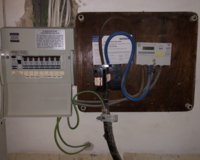One for all you sparkies and DIYers..
Following on from my post about whether hook-up cables should be armoured or not, it got me thinking about how I trickle-charge my motorbike.
My house is a 50’s build. I’ve been here 8 years and don’t know the history of the wiring, other than they’re the old black and red cables.
The consumer unit / fuse box / RCD looks something like this:

It’s stuffed away behind a cupboard and doesn’t cause any issues - the lights will sometimes dim if loads of devices are running and something hefty like a kettle is switched on - but rarely trips out (it does work, I know that much at least).
Now, firstly - I want permanent power at my shed. Only enough for a light and a trickle charger, and I’ll probably run the lawnmower from there.
What’s the best way to do this - would it want it’s own consumer unit with RCD and MCBs? Or does that then take me in to notifiable territory that will cost a lot of dosh?
The shed is detached and at the side of the house, so if I want to run cable to it, I guess I’ll be burying it.
From the CU to the shed is 28 metres (not as the crow flies, but along a brick wall).
Secondly - should I upgrade this fusebox to something that doesn’t cause the whole house to trip out if and when a fuse blows? Or should I not bother, as it’s not causing me any grief.
If so, how much am I looking at?
I would rather have power permanently installed in the shed but won’t be spending a whole load of money on it just for that sake. If that means bringing the bike battery in to trickle charge it over winter, so be it.
Any advice welcome
Following on from my post about whether hook-up cables should be armoured or not, it got me thinking about how I trickle-charge my motorbike.
My house is a 50’s build. I’ve been here 8 years and don’t know the history of the wiring, other than they’re the old black and red cables.
The consumer unit / fuse box / RCD looks something like this:

It’s stuffed away behind a cupboard and doesn’t cause any issues - the lights will sometimes dim if loads of devices are running and something hefty like a kettle is switched on - but rarely trips out (it does work, I know that much at least).
Now, firstly - I want permanent power at my shed. Only enough for a light and a trickle charger, and I’ll probably run the lawnmower from there.
What’s the best way to do this - would it want it’s own consumer unit with RCD and MCBs? Or does that then take me in to notifiable territory that will cost a lot of dosh?
The shed is detached and at the side of the house, so if I want to run cable to it, I guess I’ll be burying it.
From the CU to the shed is 28 metres (not as the crow flies, but along a brick wall).
Secondly - should I upgrade this fusebox to something that doesn’t cause the whole house to trip out if and when a fuse blows? Or should I not bother, as it’s not causing me any grief.
If so, how much am I looking at?
I would rather have power permanently installed in the shed but won’t be spending a whole load of money on it just for that sake. If that means bringing the bike battery in to trickle charge it over winter, so be it.
Any advice welcome

